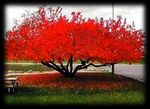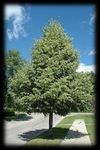2020 Boulevard Tree List - Minot Park District
←
→
Page content transcription
If your browser does not render page correctly, please read the page content below
2020 Boulevard Tree List
Just as in year’s past we are featuring a wide variety of trees that will work in an array of different city
boulevard locations. We have larger trees for larger, more open boulevards to smaller trees for smaller
boulevards or those with overhead power lines. Nearly all trees have some sort of beautiful fall color
and most of our smaller varieties flower. Limited supply.
We normally stop planting early July due to heat and shortage of tree supply.
Depending on how many trees are left we may begin planting again in
September.
The Process:
How do you get these beautiful trees in your boulevard?!
❖ Call our Forestry Department at (701)857-4178. Let us know you are interested. We will
need some information such as:
• Your name
• A phone number at which you can be reached
• Your address
• And what type of tree you are interested in
❖ Next, we will send out a qualified technician to measure and inspect your boulevard.
(You do not need to be there). The things we look for are:
• How wide is your boulevard
• How long is it
• Are there overhead or underground lines to watch out for
• And what kind of soil is there
(All these things will help us decide what type of tree and how many trees
your boulevard will be able to support.)
❖ Once you have the type of tree selected, place your order with our office. The cost for
all the trees is $125.00 for the tree, planting, staking, and mulching (the homeowner is
in charge of the watering and care of the tree). If you want a one-year warranty (this is
one year from the date it was planted) it is an extra $25.00 per tree.
• Trees will vary in size according to variety of tree. Sizes range from
10’/1.75” – 4’/.5”.
❖ Next your payment is made to our main office. Make checks payable to the ‘Minot Park
District’. 420 3rd Ave SW PO Box 538.
❖ Once we receive verification of payment you will be set for planting.
1LARGE TREES
Valley Forge Elm – Ulmus Americana
The ‘Valley Forge’ Ulmus Americana has been proven to be highly resistant to Dutch elm disease,
showing 96% survival rate. Possesses the classic American elm tree shape, transplants easily, is fast
growing and exhibits tolerance to salts, drought, poor soil conditions and air pollution. This elm is a
large shade tree growing up to 60-70’ with a 50-60’ spread. Leaves typically turn an undistinguished
yellow in fall.
Yellowwood – Cladrastis kentukea
The Yellowwood is a large tree that can reach a hight of 30-50’ with a spread of 40-55’ that grows at a
moderate rate. It produces clusters of white pea-like floweres in the Spring. Heavy flowering occurs in
alternate years. A prime ornamental characteristic is its low-branching form with a broad, rounded
crown of delicate branches. The tree’s beautiful branch framework adds winter interest, enhanced by
its smooth, gray bark.
2Prairie Expedition Elm – Ulmus americana
Like other elms, its mature hight is around 60’ with a spread of 35-50’. Grows at a medium to fast rate.
It has the classic cathedral/umbrella form that makes them so desirable. Rough-texted, ovate-elliptic,
dark green leaves have toothed margins and asymetrical bases. Leaves typically turn an
undistinguished yellow in fall. This tree is highly resistant to Dutch Elm Disease.
Silver Queen Maple – Acer saccharinum
‘Silver Queen’ is typically fast-growing, somewhat graceful
tree to the height of 40-50’ with a spread of 40-50’. This is one
of the largest deciduous trees know for its silvery undersides
of its leaves. Grows tall with a rounded open spreading crown.
Fall color is usually unremarkable and distinguished from the
species by having better yellow fall color.
3American Linden – Tilia americana
The American Linden is a fast –growing tree that can reach a
height of 60-70’ with a 40-45’ spread. Pyramidal when young then
becoming rounded with maturity. This tree will develop to its full
potential if given full sun and rich, moist, well-drained soil. Winter
hardy and is noted for its adaptability.
Northern Red Oak – Quercus rubra
The red oak is a good street tree, tolerates pollution and compacted soil. This tree grows at a fast rate,
with a height 60-70’ and a spread of around 45’ at maturity. Provides great fall color, with leaves
turning russet-red to bright red. Yeilds acorns that are round and ¾-1” long with a flat, think, saucer-
like cap. Acorns from this tree are at the top of the food preference list for blue jays, wild turkeys,
squirrels and deer.
4MEDIUM TREES
Autumn Blaze Maple – Acer x freemanii
Autumn blaze maples have tons of thick, green, lush leaves that glimmer in the sun all spring and
summer long. In the fall the abdundant green leaves turn a shade of fiery red that attracts attention
from all over. The show stopping color is one of the brightest shades of fall color red available. The
fastest growing maple from 3-5 feet a year once the roots have established after 2-3 years. Growing to
a height of 40-55’ and a sread of 30-40’. They can withstand freezing temperatures down to -40
degrees Fahrenheit. (Suggested planting in riverbottom areas. Not far north nor far south).
October Glory Maple – Acer rubrum
This hard- working, gorgeous tree will bring you so much joy! Dark green leaves drape the branches all
summer long and cast a wonderfully lush shade. Then the entrancing fall color display starts. In fact,
the display of orange, yellow and red leaves lasts far
longer than other maples. Hardy and adaptable. Fast
growing to a height of 40-50’ with a spread of 30-40’.
You’ll love the formal look added to your home.
5Greenspire Linden – Tilia cordata
Greenspire is a magnificent shade tree with a strong, spire-
like shape throughout its life and fragrant yellow flowers in
early summer when few trees bloom. The heart-shaped
leaves turn an outstanding gold in the fall. The tree will
grow to 40-50’ with a spread 30-35’ at a medium rate. It is
very tidy and low-maintenance, adaptable and excellent for
street side.
Northern AcClaim Honeylocust – Gledistia triacanthos
Northern AcClaim is seedless and maintains attractive bright green foliage during the summer months
changing to golden-yellow in the fall. Minimum leaf litter, making autumn cleanup unnecessary. Uses
for this cultivar are in landscape, boulevard and parks where an attractive hardy ornamental tree is
desired. Moderate to fast growing to a height of 40-50’ and spread of 30-35’.
6Northern Strain Redbud – Cercis canadensis
A spectacular and hardy spring bloomer, with very
showy pink to purple flowers held tightly on bare
branches in early spring. It has forest green foliage
which heart-shaped leaves turn buttery yellow in fall.
Grows at a medium rate to a height of 25’ spreading to
30’. Good for planting under power lines.
Spring Snow Crab – Malus ‘Spring Snow’
The Spring Snow Crab is a longtime running favorite. It
is a medium sized tree that grows to about 20-25’ tall
and 15’ wide. It is prized for its flowers and fruitless
nature. It blooms in late spring and it’s leaves have a
yellow fall color. It is a hardy tree but due to the fact
that it is from the Malus family it is susceptible to
carious diseases including apple scab and powdery
mildew in cool moist seasons.
7SMALL TREES
Ivory Silk Japanese Tree Lilac – Syringa reticulata
Its best ornamental feature is its showy, fragrant, creamy white flowers which bloom late spring to
early summer (later than most other lilac species). Typically grows as a small tree to 30’ tall and 20’
wide with an oval-rounded crown. Sharply-tipped, lanceolate to ovate, dark green leaves. No fall color.
Amur Maple – Acer ginnala
The main ornamental value of Amur Maple is its red fall color and fruit. This is an excellent low growing
tree for under powerlines. Growing to a height of 15-20’ with a spread of 15-20’. Creamy white flowers
appear with new foliage in spring. It is reasonably drought tolerant. It will tolerate shade, but
developes a better fall color if grown in full sun.
Prevent dehydration when grown in hotter areas.
Has a moderate growth rate.
8You can also read



























































